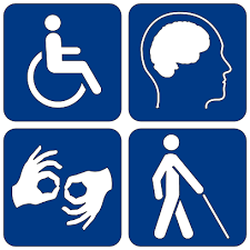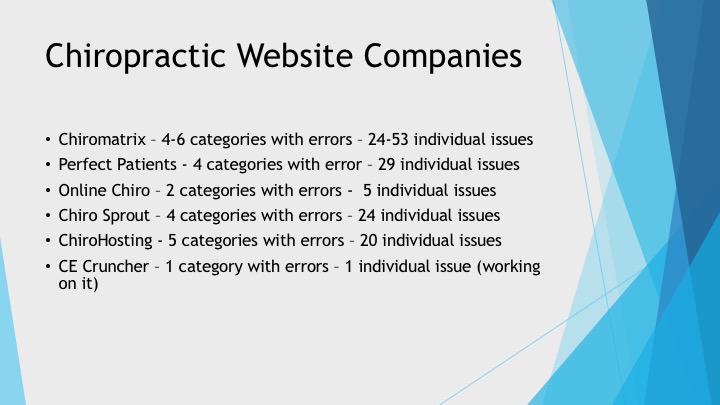Chiropractic Websites, ADA Compliance and Legal Threats
-
.gif)
Poster Profile:
Name: DrTirpak
Email: Amy@cecruncher.com
Age: ????
Location: Tampa, FL
Position: Owner
Sign: Gemini
Bio:Helping Chiropractors find some class is my job.
Experienced Chiroprctor and Internet lover, Amy Tirpak, DC, started CE Cruncher with the support of the Advertising Agency that she co-owns.
by: DrTirpak posted: December 31, 2016

Chiropractors, ADA Website Compliance and Legal Threats
I received a call last week from Kathy Jones of NACA Texas about letters surfacing around the country (Texas, New York, Connecticut) from law firms threatening civil litigation against Chiropractors stating their websites discriminate against individuals with visual, hearing, or physical manual dexterity impairments under the Americans with Disabilities Act (ADA). The letters threaten civil litigation or a payment in lieu of litigation since their websites were inaccessible, violating the ADA. Unfortunately, many DCs have out of fear and lack of understanding have paid these ransoms to the plaintiff’s law firms. After giving two webinars on the topic last week with NACA Texas last week I decided I better share the information with more Chiropractors across the US.
Web accessibility lawsuits and threats are only the latest exploit of the ADA, volumes of cases have been threatened and litigated over physical barriers in businesses and now websites. The new slew of ADA website threats in Texas comes on the heels of verdicts against major retailers Target, Winn Dixie and a few others with substantial payouts. Chiropractors and other healthcare business have been targeted in these new legal threats in Texas from Austin ADA attorney Omar Weaver Rosales.
Understanding the Law –
Enacted in 1990 the Americans with Disabilities Act prohibits discrimination and ensures equal opportunity for persons with disabilities in employment, State and local government services, public accommodations, commercial facilities, and transportation. The American Disability Act is comprised of 3 parts: Title I, II and III. Title I pertains to employment and hiring, II is for state and local government, and III applies to any businesses private or public that offers public accommodations. The ADA lists twelve separate categories of business, one being doctors’ and dentists’ offices.
The suggested violations in the letters fall under the American Disability Act’s title III. The Department of Justice has taken the position that title III covers websites of public accommodations, although title III does not specifically mention the Internet. The only guidelines for websites mentioned in the entire act are located in title II, Accessibility of State and Local Government Websites to People with Disabilities (June 2003) which refers to the Web Content Accessibility Guidelines from the World Wide Web Consortium (W3C®) and the ADA tool kit.
What makes a website accessible? The Web Content Accessibility Guidelines (WCAG 2.0) from the World Wide Web Consortium (W3C®) that the ADA references are a set of programming standards that most professional web development companies and programmers integrate into their websites. The W3C is an international community of the foremost experts in programming and web development that creates open standards to ensure the long-term growth of the Web.
These standards were developed to ensure universal parameters for adaptive hardware and software to improve the internet browsing experience of those with impairments. Almost all of the items criteria would not be noticed by an internet user unless they were using adaptive technology. They include language that describes pictures, captions for videos and name descriptions for links, flashing items, audio that auto-plays and much more.
As a chiropractor and owner of a web development firm, the above information is difficult at best. Unless you are a web programmer not much will make much sense. It would be on par with explaining how to palpate and adjust C1 to a non-Chiropractor. I found a number of website checkers. Just enter your url and results populated. Unfortunately, they all offered varying results and did not include all aspects of the guidelines and many were outdated.
If you are now afraid that your websites may not be accessible, one exception does exist. According to the DOJ your business may meet its legal obligations by providing an accessible alternative for individuals to enjoy its goods or services, such as a staffed telephone information line. The website alternative must provide an equal degree of access in terms of hours of operation and range of options and programs available, so it would have to be available 24 hours a day, seven days a week. If you do not have a call service keep reading.
Chiropractic Websites -
My staff and I completed a check of the largest providers of Chiropractic websites and generated these results. I choose sites of friends, colleagues and individual chiropractor’s websites listed on chiropractic websites development companies’ sites.

Based on the ADA guidelines, our reviews of Chiropractic websites and claims made in the lawsuits we created this list of areas of concern:
♦ Ecommerce and shopping cart. All images need alt tags and the checkout process needs to have labels on every form
♦ Downloadable Forms – If you have new patient forms posted on your site as downloadable files include them not only as .pdf but html and .rtf formats. Make sure if it is a fillable form online that it ♦ includes descriptive HTML tags for all images and links.
♦ Make an appointment - If this is an application on your site make sure that it includes descriptive HTML tags.
♦ Video – Avoid Flash. If the video is embedded from youtube.com add the caption option. Complaints have been made of youtube.com’s caption service, but it is better than nothing. Instead of embedding the video just include a link (with an alt tag) and let another company take responsibility for the captions.
♦ Frames – Don’t use them on your website.
♦ Jump Navigation
Now that you are good and scared that a letter will show up in your mail box disparaging your website, what do you do? If you receive a letter call an attorney familiar with healthcare law and these cases. (We know a few.) Most Chiropractors, unless they are web programmers are not going to be able to discern if their websites meet these requirements. You can ask your web developer if your Chiropractic website is compliant, but how do you really know?
For any Doctors of Chiropractic stressed out after reading this article we are offering a $99 Peace of Mind Review. We will review your Chiropractic Website, generate a report, help you correct the ADA compliance issues, offer suggestions to your web programmer and recheck the site once the corrections are made.
CE Cruncher also offers ADA compliant Chiropractic Websites, with editable content, built in SEO, email blasts and practice specific content creation.





 Permalink
Permalink
